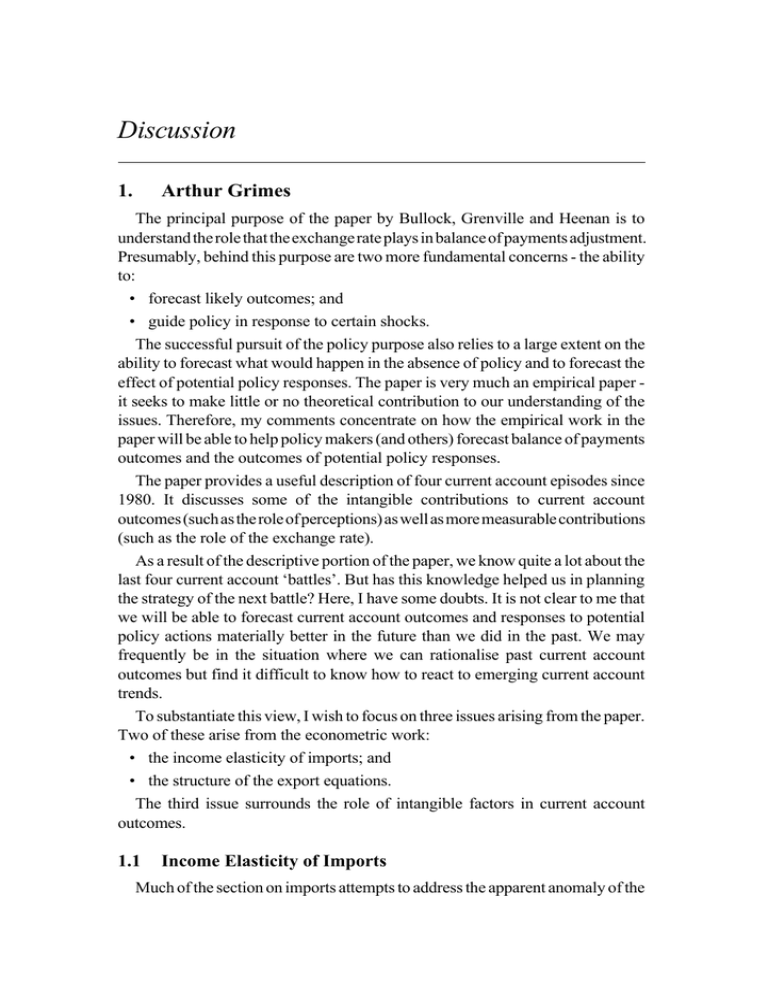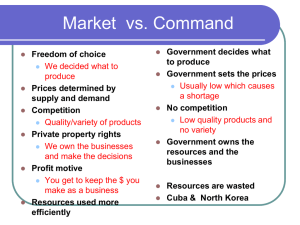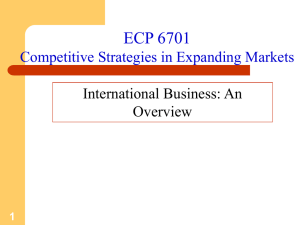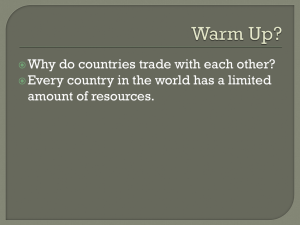Discussion 1. Arthur Grimes
advertisement

142 Discussion Discussion 1. Arthur Grimes The principal purpose of the paper by Bullock, Grenville and Heenan is to understand the role that the exchange rate plays in balance of payments adjustment. Presumably, behind this purpose are two more fundamental concerns - the ability to: • forecast likely outcomes; and • guide policy in response to certain shocks. The successful pursuit of the policy purpose also relies to a large extent on the ability to forecast what would happen in the absence of policy and to forecast the effect of potential policy responses. The paper is very much an empirical paper it seeks to make little or no theoretical contribution to our understanding of the issues. Therefore, my comments concentrate on how the empirical work in the paper will be able to help policy makers (and others) forecast balance of payments outcomes and the outcomes of potential policy responses. The paper provides a useful description of four current account episodes since 1980. It discusses some of the intangible contributions to current account outcomes (such as the role of perceptions) as well as more measurable contributions (such as the role of the exchange rate). As a result of the descriptive portion of the paper, we know quite a lot about the last four current account ‘battles’. But has this knowledge helped us in planning the strategy of the next battle? Here, I have some doubts. It is not clear to me that we will be able to forecast current account outcomes and responses to potential policy actions materially better in the future than we did in the past. We may frequently be in the situation where we can rationalise past current account outcomes but find it difficult to know how to react to emerging current account trends. To substantiate this view, I wish to focus on three issues arising from the paper. Two of these arise from the econometric work: • the income elasticity of imports; and • the structure of the export equations. The third issue surrounds the role of intangible factors in current account outcomes. 1.1 Income Elasticity of Imports Much of the section on imports attempts to address the apparent anomaly of the The Exchange Rate and the Current Account 143 income elasticity of the demand for imports being significantly greater than unity. This restriction is adopted in most standard growth models. I was pleased to see that the authors did attempt to address this issue at a slightly disaggregated level. My own experience is that this is necessary, given that imports are far from homogeneous and that the elasticities differ substantially across product groupings. It was unfortunate, therefore, that the import equations for capital goods were not able to be specified in the hypothesised form as a function of real investment in plant and equipment. Possibly the problems relate to the very short sample period (12 years used here) or to the lack of homogeneity even amongst investment goods. Even the disaggregated approach is unable to obtain an income elasticity close to unity. On reflection, the attempt to find some functional form that enables the unity restriction to be accepted is probably a fruitless exercise. My experience using New Zealand data is that I have never been able to accept this restriction. Nor should this be at all surprising. The authors note that since 1960 international trade has grown roughly twice as fast as GDP growth in OECD countries. The ratio of exports to GDP has risen by between 50 and 100 per cent in most of the countries cited in the paper. These statistics are not likely to be consistent with each country having an income elasticity of unity for imports. Rather, as country incomes increase, people demand to purchase a greater proportion of foreign goods: on average, imports in most countries are treated as luxury goods. Given this observation, I see little to be gained in trying to explain away the high estimated income coefficient. As a corollary, regarding the effect of tariffs on imports, I doubt the results obtained from a model that restricts income elasticity to unity. 1.2 Specification of Export Equations I had considerable difficulty in interpreting the manufacturing export equations provided in the paper. An ad hoc specification of the equation is thrown up and estimated, sometimes supplemented by additional variables. The initial group of variables implies that a demand equation is being estimated. This is consistent with the observation in the paper that Australian manufacturers tend to be price makers. The explanatory power of the initial demand equation is low [R2 = 0.15]. This makes one wary about the estimated coefficients in the equation as it could suffer materially from omitted variables bias. The possible collinearity of the real exchange rate with the intangible factors discussed in the paper makes the coefficient on the real exchange rate term, in particular, somewhat suspect. The authors proceed to supplement the initial demand equation with additional supply-side factors. I have problems with this approach. We know from basic 144 Discussion econometrics that a combination of supply and demand factors in the same equation leaves nothing that can be interpreted structurally; indeed the authors note that they obtain non-structural estimates. As a result one cannot assert, even on the basis of the estimated coefficients, that a policy-induced 1 per cent (real) exchange rate depreciation will induce a 5 or 6 per cent rise in manufactured exports. We are left none the wiser from this exercise as to what will happen to manufactured exports if policy makers are able to induce a real exchange rate change. Similarly, we cannot advise what will be the likely future response to further tariff changes on the basis of these equations. Policy prescriptions and forecasts do not seem to have been facilitated materially by this exercise. 1.3 Intangibles Throughout the paper, a number of intangible elements are discussed that are hypothesised to have contributed to some of the cited balance of payments outcomes. Such elements include: • newly recognised realities of higher foreign debt; • recognition of the limited benefits of the 1980s minerals boom; • attitudinal and unquantifiable changes reflected in the newly found emphasis on export orientation and ‘world-best practice’; • psychological (and financial) government support for exporting; • peer pressure; and • media attention. These elements are all plausible. Indeed, in many ways they probably explain as much, if not more, of the outcomes than do the measurable factors. Further, many of these intangible developments will be correlated with the sharp depreciation in Australia’s real exchange rate in the second half of the 1980s. This factor is likely to have caused a problem in obtaining reliable export elasticities and will have been exacerbated by the unusually pronounced real exchange rate change which may have had a once-and-for-all effect on the perceptions of potential exporters. Thus a 15 per cent change in the real exchange rate may have been associated with a 75 per cent change in manufactured exports, but a 1 per cent real exchange rate change may have considerably less than a 5 per cent effect on manufactured export volumes. If the econometric estimates are difficult to use for forecasting and policy purposes, one might be tempted to revert to the macroeconomic approach adopted earlier in the paper and look instead at investment and terms of trade developments. Unfortunately, this approach is also likely to reveal little about emerging current account developments because of the difficulties in interpreting investment and terms of trade trends. Investment trends themselves are probably the most difficult The Exchange Rate and the Current Account 145 of all the macroeconomic variables to forecast, seemingly being explained as much by ‘animal spirits’ as by any variable entering explicitly into the investment equation. And anyone who can predict the terms of trade (especially in a commodity producing country) should be playing the commodity futures market, not working in a central bank. Thus, it appears that even though we can describe past episodes, we are left as impotent as ever at predicting when a renewed current account crisis is about to occur. And even if we could do so, the econometric estimates would not tell us much about how exports, in particular, would respond to potential policy measures. This pessimistic conclusion is not principally a criticism of the paper, but a realisation, based on experience, that interpreting and predicting developments in the current account - the almost negligible balance between two huge flows - is an extraordinarily difficult task. 2. General Discussion Discussion about the Bullock, Grenville and Heenan paper centred on the estimated elasticities presented in the paper and the links between the government budget deficit, the savings-investment relationship and the current account balance. There was considerable discussion concerning the size of the income elasticities of imports presented in the paper, with a number of speakers arguing that they were unreasonably high. Imports, in the long run, cannot increase indefinitely as a share of GDP. On the other hand, several participants argued that the estimates were not unreasonably high. Some of the views expressed were that: • attempts to disaggregate the data had not gone far enough. Further disaggregation might increase the price elasticities and reduce the income elasticities; • while the income elasticity might be close to unity in the very long run, sample periods were not long enough to allow this to be identified. Since the Second World War the growth in the volume of world trade has systematically exceeded the growth in output, suggesting that this was certainly not a long enough period in which to identify a unit elasticity; and • it was questionable as to whether or not unit income elasticity of imports was a reasonable assumption for the long run. As incomes rise, the desire for variety also increases. This leads to imports growing faster than income. In addition to this, a ‘ratchet’ effect was suggested. When income falls the desire for variety does not fall, so that business cycle swings lead to a gradual ratcheting up of the import share of GDP. This ratchet effect may make it difficult to estimate the dynamics of adjustment. 146 Discussion The size of the price elasticities of imports and exports also received considerable attention. One speaker noted that generally, in the case of industrial countries, price elasticities are often estimated to be around unity. Such estimates might be considered to be low, since they are calculated over periods when the structure of the economy is broadly given. In the long run, changes in relative prices can affect the structure of the economy. If these effects could be taken into account, much larger elasticities might be identified. Some participants wondered whether the high export price elasticities estimated from the bilateral trade data in the paper might have been due to the failure to take account of non-linearities. The exchange rate changes in the mid-1980s had been very large, going well beyond inertia bands present in the case of smaller exchange rate fluctuations. This may have stimulated exports, and once ‘beachheads’ had been established in new markets, improved export performance continued in spite of subsequent adverse exchange rate movements. There was also some discussion of the role that reducing protection plays in increasing trade penetration ratios. One speaker argued that the international evidence was that declines in tariffs generated a much larger increase in exports than had been expected. There was fairly widespread, though not universal, support for the notion that the changes in protection were an important catalyst for much of the recent change in Australia’s trade penetration ratios. However, it was also argued that in a period of rapid structural change, like the one Australia has been experiencing recently, it is difficult to be precise about attributing changes in imports and exports to specific variables. In this respect, there was considerable support for the notion that the parameters presented in the paper are period specific. Several issues concerning the relationship between budget deficits, the savings-investment relationship and the current account balance were also discussed. Many participants voiced the view that changes in the savings-investment balance could affect the real exchange rate and hence the current account. There was some dispute about the links that exist between the current account and the budget deficit. Some participants felt that the budget deficit was a serious problem for Australia and that if there was not a major policy change in the near future, prospects for the savings-investment balance further down the track would deteriorate. Ultimately this would increase the difficulty of achieving external adjustment. Other participants pointed out that the Australian Government’s debt-to-GDP ratio was one of the lowest in the OECD. This was taken as evidence that the budget deficit could be used for stimulatory purposes in the short run, and would not necessarily be a constraint on achieving external balance later on. On this view, fiscal policy and the current account should not be considered as being inextricably linked.





